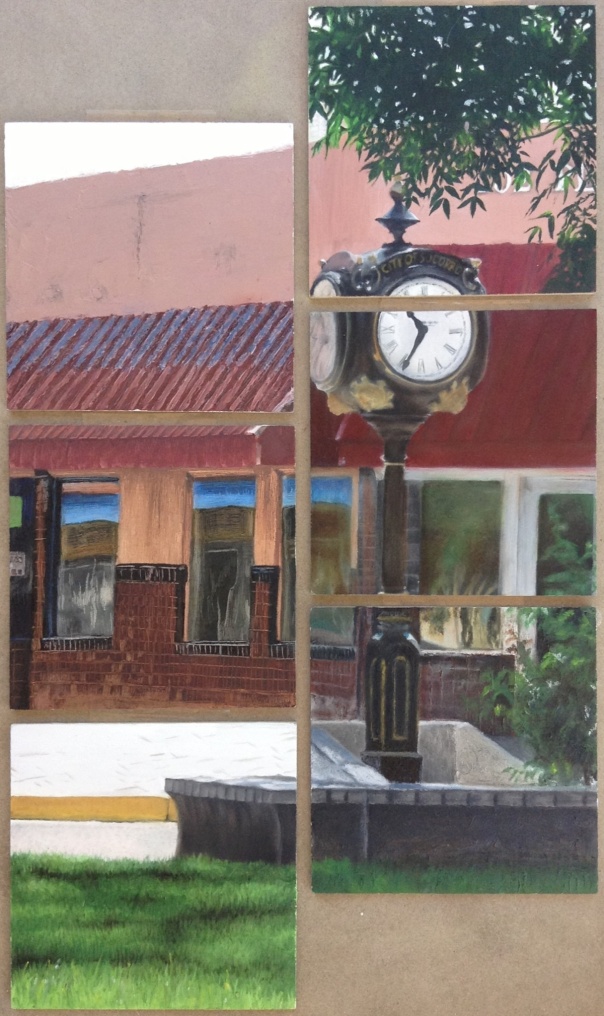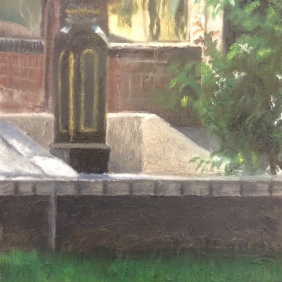It’s been a while since I’ve posted, although it doesn’t feel like it… It was quite a shock to see that my last post was from January of this year. So much has happened, but first I’d like to share with you some work from the rest of my semester in Painting I.
First image: a “six squares project” to demonstrate mastery of six painting techniques/color schemes. The assignment required six 6″x6″ squares of wood panel. The finished project could either be six parts of a cohesive image (the format that I selected), or the same image executed in different techniques. When I find the original photo that I used, I’ll be updating this post by adding it–just so you can see the image I worked from.
It was quite difficult to chose a photo that I thought would suit this project, mostly because two of the “techniques” were analogous colors and complimentary colors. The photo that I chose featured complimentary colors (red and green) in the top right corner and analogous colors (green, yellow-green, and yellow) in the lower left corner, so those two squares were already spoken for.

The other four techniques were palette knife (top left), sgraffito (middle left), glaze over grisaille (middle right), and dry brush scumbling (lower right).
The other reason that I chose this photo was because I took it about a year ago in Socorro, NM (where I went to college for Engineering & Business Management). There were many things that were not ideal about my time in Socorro, but the town still feels like an old friend. It’s like that person that you said you never wanted to see again, but still miss every day… 😉
The palette knife painting was done in just one layer, but the remaining three painting techniques required some degree of layering. Here are the under-paintings and the finished products, just so you can get an idea of what each technique looked like at each crucial point.
SGRAFFITO
Sgraffito utilizes an under-painting that is first allowed to completely dry. Then, the next layer of paint is applied and a tool is used to scratch through to the first layer, exposing the color of the under-painting in scratched marks. I used vibrant color blocks for the under-painting that allowed me to take advantage of some brighter colors once my somber topcoat was applied.
GLAZE OVER GRISAILLE
The word grisaille is derived from the French, and essentially means that the artwork has been completed in grayscale. The technique of glaze over grisaille, then, requires completing a painting of the image in full-value grayscale, allowing it to dry, and then adding color with thin coats of transparent color. Some oil colors are transparent, and some are not, so it was very important to keep that in mind when glazing the painting. An opaque paint would muddy the finished product. This technique–while amazing–is not my favorite. I’m used to a crisp image, and was frustrated by the way that the glazes wanted to travel all over the piece. Still, I came to peace with the end result. 🙂 Here is the grisaille, followed by the finished product.
SCUMBLING
This technique was one of my favorites. The under-painting for scumbling requires a thick, textured application of paint, painted in blocks (like a sgraffito under-painting), with little detail. Once the under-painting has dried, paint is applied by dragging the brush over the textured surface. Here is the under-painting, followed by the finished product (which has, unfortunately, been a bit “washed out” by the lighting present when the photo was taken).
The six squares project took an interminable amount of time. Still, as with almost any permanent project, memory of the work (and pain and suffering) required will fade with time, but the piece will still remain fresh.






